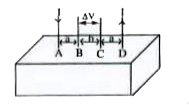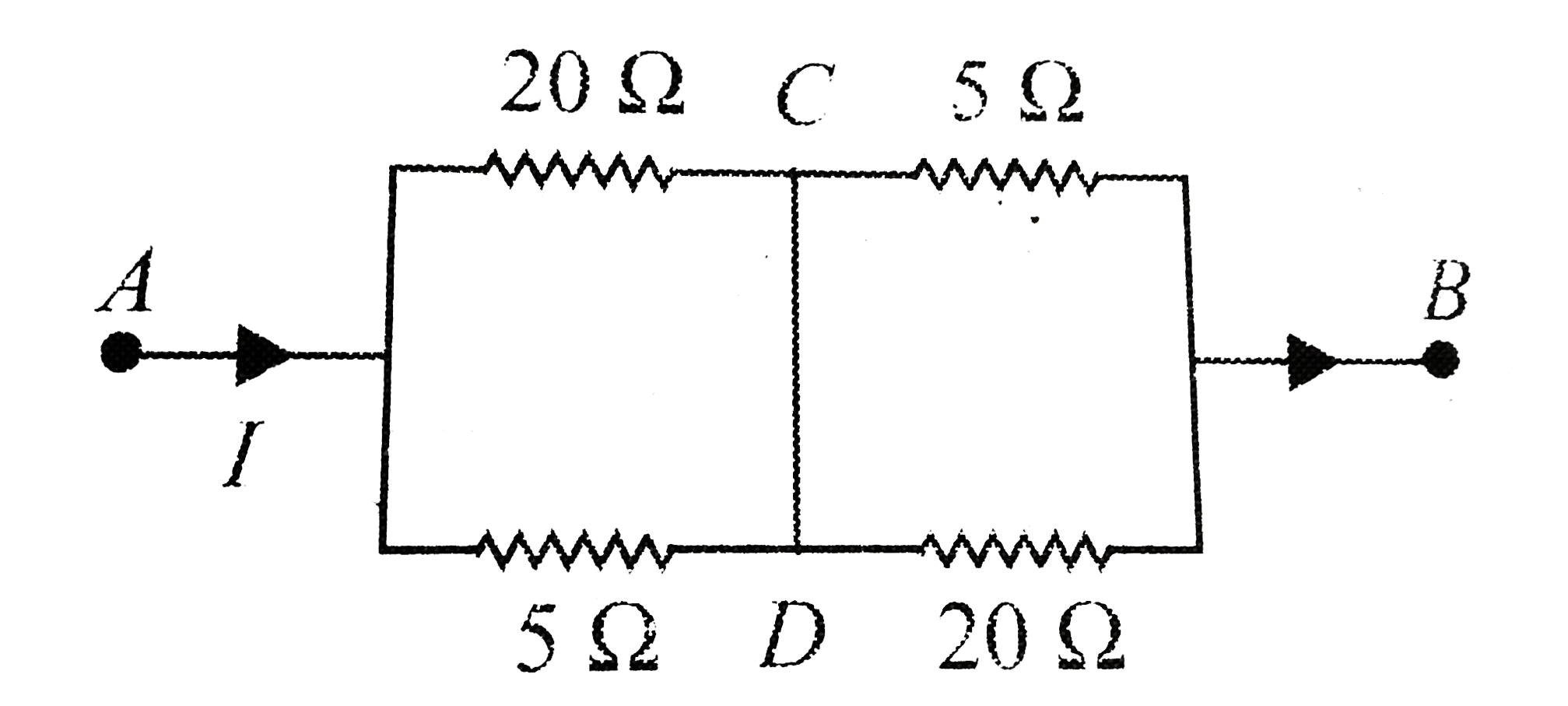Consider a block of conducting material of resistivity p shown in the figure. Current I enters at A and leaves from D. We apply superposition principle to find voltage developed between B and C. The calculation is done in the following steps :

(i) Take current I entering from A and assume it to spread over a hemispherical surface in the block.
(ii) Calculate filed E(r) at distance r from A by using Ohm’s law where j is the current per unit area at r.
(iii) From the r dependence of E(r), obtain the potential V(r) at r.
(iv) Repeat (i), (ii) and (iii) for current I leaving D and superpose result for A and D.
measured between B and C is :
The correct Answer is:C
Step by step video & image solution for Consider a block of conducting material of resistivity p shown in the figure. Current I enters at A and leaves from D. We apply superposition principle to find voltage Delta v developed between B and C. The calculation is done in the following steps : (i) Take current I entering from A and assume it to spread over a hemispherical surface in the block. (ii) Calculate filed E(r) at distance r from A by using Ohm’s law E=pi where j is the current per unit area at r. (iii) From the r dependence of E(r), obtain the potential V(r) at r. (iv) Repeat (i), (ii) and (iii) for current I leaving D and superpose result for A and D. Delta vmeasured between B and C is : by Physics experts to help you in doubts & scoring excellent marks in Class 12 exams.
Topper's Solved these Questions
- BOOK - AAKASH SERIESCHAPTER - CURRENT ELECTRICITYEXERCISE - PRACTICE SHEET (EXERCISE - I LEVEL-II (ADVANCED) (Matrix Matching Type Questions))1videos
CURRENT ELECTRICITY
- BOOK - AAKASH SERIESCHAPTER - CURRENT ELECTRICITYEXERCISE - PRACTICE SHEET (EXERCISE - I LEVEL-II (ADVANCED) (Integer Type Questions))3videos
CURRENT ELECTRICITY
- BOOK - AAKASH SERIESCHAPTER - CURRENT ELECTRICITYEXERCISE - PRACTICE SHEET (EXERCISE - I LEVEL-II (ADVANCED) (More than One correct answer Type Questions))1videos
CURRENT ELECTRICITY
- BOOK - AAKASH SERIESCHAPTER - CURRENT ELECTRICITYEXERCISE - PROBLEMS (LEVEL-II)27videos
CURRENT ELECTRICITY
- BOOK - AAKASH SERIESCHAPTER - DUAL NATURE OF RADIATION AND MATTEREXERCISE - PRACTICE EXERCISEX42videos
DUAL NATURE OF RADIATION AND MATTER
Similar Questions
Consider a block of conducting material of resistivity 'ρ' shown in the figure. Current 'I' enters at 'A' and leaves from 'D'. We apply superposition principle to find voltage ΔV developed between 'B' and 'C'. The calculation is done in the following steps:
(i) Take current 'I' entering from 'A' and assume it to spread over a hemispherical surface in the block.
(ii) Calculate field E(r) at distance 'r' from A by using Ohm's law E=ρj, where j is the current per unit area at 'r'.
(iii) From the 'r' dependence of E(r), obtain the potential V(r) at r.
(iv) Repeat (i), (ii) and (iii) for current 'I' leaving 'D' and superpose results for 'A' and 'D'.

Delta V measured between B and C isView SolutionPassage-II:
Consider a block conducting material of resistivity .ρ. shown in the figure. Current .I. enters at .A. and leaves from .D.. We apply superposition principle to find voltage .ΔV. developed between .B. and .C.. The calculation is done in the following steps :
i) Take current .I. entering from .A. and assume it to spread over a hemispherical surface in the block.
ii) Calculate field E(r ) at distance .r. from A by using Ohm.s law E=ρj, where j is the current per unit area at .r..
iii) From the .r. dependence of E(r ), obtain the potential V(r ) at r.
iv) Repeat (i), (ii), (iii) for current .I. leaving .D. and superpose results for .A. and .D..
For current entering at A the electric field at a distance .r. from A isView SolutionConsider the circuit shown in the figure. The current I3 is equal to
 View Solution
View SolutionIn the circuit shown in the figure,
 View Solution
View SolutionA conducting wire carrying current I is shown in the figure. The magnitude of magnetic field at the point P will be
 View Solution
View SolutionWhen some potential differece is maintained between A and B, current I enters the network at A and leaves at B
 View Solution
View SolutionFor the circuit shown in the figure current I will be
 View Solution
View SolutionCurrent I in the network shown in figure
 View Solution
View SolutionShows a network of currents. The magnitude of the current is shown here. Find the current. i.
 View Solution
View SolutionA current enters from A and leaves at B through the network shown. Select the correct alternative(s).
 View Solution
View Solution
